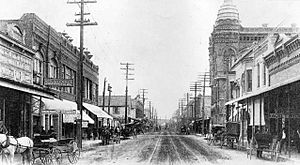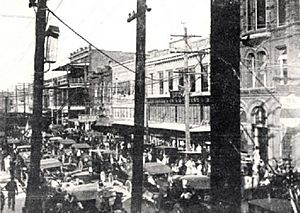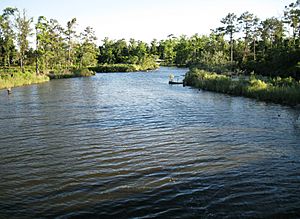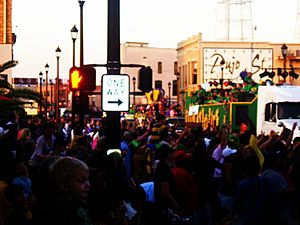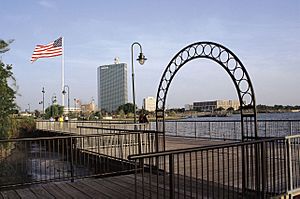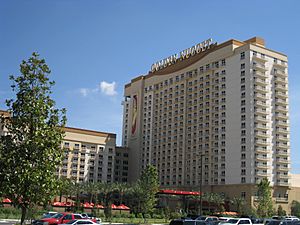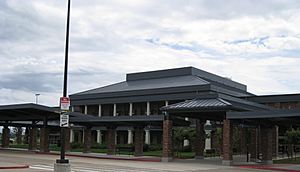Lake Charles, Louisiana facts for kids
Quick facts for kids
Lake Charles, Louisiana
|
|||||
|---|---|---|---|---|---|
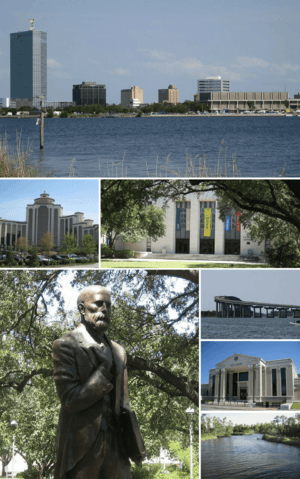
Top to bottom, L-R: Downtown Lake Charles, L'Auberge du Lac Casino, McNeese State University, John McNeese statue, Israel LaFleur Bridge, Lake Charles City Court, Henderson Bayou
|
|||||
|
|||||
| Nickname(s):
The Lake Area
|
|||||
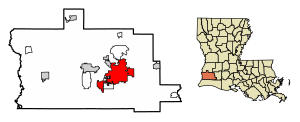
Location of Lake Charles in Calcasieu Parish, Louisiana
|
|||||
| Country | |||||
| State | |||||
| Parish | Calcasieu | ||||
| Founded | March 7, 1861 as Charleston | ||||
| Renamed | March 16, 1867 as Lake Charles | ||||
| Founded by | Charles Sallier | ||||
| Named for | Charles Sallier | ||||
| Area | |||||
| • City | 48.60 sq mi (125.87 km2) | ||||
| • Land | 45.73 sq mi (118.44 km2) | ||||
| • Water | 2.87 sq mi (7.43 km2) | ||||
| Elevation | 15 ft (5 m) | ||||
| Population
(2020)
|
|||||
| • City | 84,872 | ||||
| • Density | 1,855.98/sq mi (716.59/km2) | ||||
| • Urban | 132,977 | ||||
| • Metro | 210,409 | ||||
| Demonym(s) | Lake Charlesian | ||||
| Time zone | UTC−6 (CST) | ||||
| • Summer (DST) | UTC−5 (CST) | ||||
| ZIP Codes |
70601, 70602, 70605, 70606, 70607, 70609, 70615, 70616, 70629
|
||||
| Area Code | 337 | ||||
| FIPS code | 22-41155 | ||||
Lake Charles (French: Lac Charles) is the fifth-largest incorporated city in the U.S. state of Louisiana, located on Lake Charles, Prien Lake, and the Calcasieu River. Founded in 1861 in Calcasieu Parish, it is a major industrial, cultural, and educational center in the southwest region of the state. As of the 2020 census, Lake Charles's population was 84,872. It is considered a regionally significant center of petrochemical refining, gambling, tourism, and education, being home to McNeese State University and Sowela Technical Community College. Because of the lakes and waterways throughout the city, metropolitan Lake Charles is often called the Lake Area.
Contents
History
On March 7, 1861, Lake Charles was officially incorporated as the town of Charleston, Louisiana. Six years after the city was incorporated, dissatisfaction over the name Charleston arose; on March 16, 1867, Charleston was renamed and incorporated as the town of Lake Charles. In 1910, a fire, known as the "Great Fire of 1910", devastated much of the city.
However, Lake Charles soon rebuilt itself and continued to grow and expand in the twentieth century. The Charleston Hotel was completed in 1929, during the administration of Mayor Henry J. Geary. During and after World War II, Lake Charles experienced industrial growth with the onset of the petrochemical refining industries. The city grew to a high of some 75,000 people in the early 1980s, but with local economic recession, the population declined.
Current
With the advent of the gaming, manufacturing, and aviation maintenance industries, the city rebounded with a population of 71,993 as of 2010.
Geography
Lake Charles, located on a level plain about 30 miles (48 km) from the Gulf of Mexico, has an elevation of 13 feet (4.0 m), and is located on the banks of the Calcasieu River in southwestern Louisiana. It borders both Lake Charles and Prien Lake. Contraband Bayou, Henderson Bayou, and English Bayou flow through the city. Oak trees and pine trees dot the landscape, as the lumber industry, once the main economic engine of the area, can attest to. The Calcasieu Ship Channel, which allows large ocean-going vessels to sail up from the Gulf, also borders the city.
According to the United States Census Bureau, the city has a total area of 44.8 square miles (116.0 km2), of which 42.0 square miles (108.9 km2) is land and 2.7 square miles (7.1 km2), or 6.12%, is water.
Climate
Lake Charles is tied with Port Arthur, Texas, and Astoria, Oregon, as the most humid city in the contiguous United States, and the second-most humid measured location behind unincorporated Quillayute, Washington. The average relative humidity in Lake Charles is 90% in the morning, and 72% in the afternoon.
| Climate data for Lake Charles, Louisiana | |||||||||||||
|---|---|---|---|---|---|---|---|---|---|---|---|---|---|
| Month | Jan | Feb | Mar | Apr | May | Jun | Jul | Aug | Sep | Oct | Nov | Dec | Year |
| Record high °F (°C) | 87 (31) |
87 (31) |
94 (34) |
95 (35) |
100 (38) |
106 (41) |
103 (39) |
107 (42) |
105 (41) |
103 (39) |
93 (34) |
89 (32) |
107 (42) |
| Average high °F (°C) | 60.6 (15.9) |
64.5 (18.1) |
71.3 (21.8) |
77.4 (25.2) |
84.1 (28.9) |
88.9 (31.6) |
91.0 (32.8) |
91.3 (32.9) |
87.7 (30.9) |
80.5 (26.9) |
70.6 (21.4) |
63.3 (17.4) |
77.6 (25.3) |
| Average low °F (°C) | 41.2 (5.1) |
44.3 (6.8) |
50.8 (10.4) |
57.2 (14.0) |
65.7 (18.7) |
72.1 (22.3) |
74.3 (23.5) |
73.6 (23.1) |
69.1 (20.6) |
58.6 (14.8) |
49.7 (9.8) |
43.3 (6.3) |
58.3 (14.6) |
| Record low °F (°C) | 12 (−11) |
3 (−16) |
21 (−6) |
30 (−1) |
40 (4) |
51 (11) |
60 (16) |
59 (15) |
45 (7) |
30 (−1) |
20 (−7) |
11 (−12) |
3 (−16) |
| Average precipitation inches (mm) | 5.52 (140) |
3.28 (83) |
3.54 (90) |
3.64 (92) |
6.06 (154) |
6.07 (154) |
5.13 (130) |
4.85 (123) |
5.95 (151) |
3.94 (100) |
4.61 (117) |
4.60 (117) |
57.19 (1,451) |
| Source: NWS Lake Charles Office | |||||||||||||
Demographics
| Historical population | |||
|---|---|---|---|
| Census | Pop. | %± | |
| 1880 | 838 | — | |
| 1890 | 3,442 | 310.7% | |
| 1900 | 6,680 | 94.1% | |
| 1910 | 11,449 | 71.4% | |
| 1920 | 13,088 | 14.3% | |
| 1930 | 15,791 | 20.7% | |
| 1940 | 21,207 | 34.3% | |
| 1950 | 41,272 | 94.6% | |
| 1960 | 63,392 | 53.6% | |
| 1970 | 77,998 | 23.0% | |
| 1980 | 75,226 | −3.6% | |
| 1990 | 70,580 | −6.2% | |
| 2000 | 71,757 | 1.7% | |
| 2010 | 71,993 | 0.3% | |
| 2020 | 84,872 | 17.9% | |
| U.S. Decennial Census | |||
Lake Charles is the principal city of the Lake Charles Metropolitan Statistical Area, which has a population of 202,040. It is the larger principal city of the Lake Charles-Jennings Combined Statistical Area, with a population of 225,235. The 2010 population of the five-parish area of Southwest Louisiana was 292,619.
2020 census
| Race | Number | Percentage |
|---|---|---|
| American Indian and Alaska Native | 340 | 0.4% |
| Asian | 2,244 | 2.6% |
| Black or African American (non-Hispanic) | 39,199 | 46.2% |
| Hispanic or Latino | 4,772 | 5.6% |
| Native Hawaiian and Other Pacific Islander | 82 | 0.1% |
| Not Hispanic or Latino | 35,143 | 41.4% |
| Some Other Race | 2,205 | 2.6% |
| Two or More Races | 4,744 | 5.6% |
| White (non-Hispanic) | 36,058 | 42.5% |
As of the 2020 census, the population was 84,872. In 2020, the population density was 1,890 people per square mile. There were 38,434 housing units.
There were 32,614 households, out of which 21.5% had children under the age of 18 living with them. The average household size was 3.00 and the average family size was 3.27.
The population was spread out, with 21.5% under the age of 18, 14.8% from 20 to 24, 25% from 25 to 44, 22.9% from 45 to 64, and 16.2% who were 65 years of age or older. The median age was 37 years. 7.1% were veterans.
The median income for a household in the city was $37,894. 26.7% of the population was below the poverty line. The average commute time was 22.4 minutes.
2010 census
As of the 2010 census, the population was 71,993. In 2010, the population density was 1,711.8 people per square mile (689.7/km2). There were 32,469 housing units. The racial makeup of the city was 47% African American, 46% White <1% Native American, 2% Asian, 1% from other races, 2% from two or more races. Hispanic or Latino people of any race were 3% of the population.
There were 28,228 households, out of which 26.6% had children under the age of 18 living with them, 37.8% were married couples living together, 18.3% had a female householder with no husband present, and 39.4% were non-families. 33.6% of all households were made up of individuals, and 12.1% had someone living alone who was 65 years of age or older. The average household size was 2.43 and the average family size was 3.13.
In 2010, the population was spread out, with 27% under the age of 18, 8.5% from 20 to 24, 24.8% from 25 to 44, 25% from 45 to 64, and 14.1% who were 65 years of age or older. The median age was 35 years. For every 100 females, there were 90.9 males. The percentage of males was 45.7% versus 54.3% for females.
The median income for a household in the city was $36,001. The per capita income for the city was $22,855. 20.9% of the population was below the poverty line.
Religion
Christianity is the predominant religion in the Lake Area. Roman Catholicism is the largest individual denomination, claiming about 50% of the population. Lake Charles is also home to various Protestant Christian denominations, the largest being the Southern Baptist congregation with 30%. There is a ward of The Church of Jesus Christ of Latter-day Saints in Lake Charles. There are also religious communities from other faiths such as Islam, Judaism and Eastern Orthodox Christianity.
Culture
Arts and culture
Lake Charles has a strong Creole & Cajun culture because of its location in south Louisiana. The city has its own symphony orchestra, the Lake Charles Symphony. It was founded in 1938 and hosts concerts at the Rosa Hart Theatre, which has a capacity of over 2,000.
Lake Charles is home to a number of museums and art galleries. The largest, Imperial Calcasieu Museum, features a permanent historic exhibit with artifacts and an art gallery. Its grounds are home to the Sallier oak tree, which is around 400 years old. The Historic City Hall Arts and Cultural Center is used as exhibition space; moving art exhibits are displayed at this public art gallery each month. It also hosts the Charlestown Farmers' Market, which provides a venue for local farmers and merchants to sell goods. The USS Orleck Naval Museum, a naval destroyer from 1945, is open for public tours as a veterans memorial and museum. It is located on the river in North Lake Charles.
The Central School Arts and Humanities Center, located in the historic Charpentier District, is owned by the city. Charpentier is French for carpenter, a reference to the carpenter-architects who built the mixed-style homes in the district. Central School features the Black Heritage Art Gallery, which is on the Louisiana African American Heritage Trail as well as the Mardi Gras Museum of Imperial Calcasieu, which features extravagant costumes and an interactive float. It has the largest collection of Mardi Gras memorabilia in the South. Other studios and cultural activities include the Art Associates Gallery, Studio 347 Gallery, the Lake Charles Symphony, and the Lake Charles Community Band.
McNeese State University annually produces the Banners Series, a series of various musical and theatrical performances. Banners also hosts lectures and presentations from notable persons and academics. Local theaters include the Lake Charles Little Theatre, the Artists Civic Theatre and Studio (ACTS), and the Children's Theatre.
Mardi Gras
Mardi Gras in Lake Charles has a long history dating back to 1882, when Momus, King of Mardi Gras, landed his royal yacht at the foot of Pujo Street downtown. Throughout the two World Wars, Mardi Gras was downsized which led to a lack of participation by the area's youth. However, an interest to redevelop the festivities arose, and the first Mardi Gras Ball in Lake Charles was staged in 1964. The full revival of Mardi Gras in Lake Charles was not realized until 1979, when several Krewe captains formed the "Krewe of Krewes", with the primary purpose of parading and promoting Mardi Gras for local residents. In 1985, Mardi Gras of Imperial Calcasieu, Inc. was formed by a group of civic-minded volunteers to further aid in the preservation of this festival. Mardi Gras in Lake Charles regularly draws in crowds of 150,000.
Contraband Days
Many festivals are held at the Civic Center. The most popular, Contraband Days, is hosted on the Civic Center grounds and lakefront. Contraband Days is a twelve-day annual festival held during the first two weeks of May. The celebrations are filled with savory Cajun food, family fun, and live entertainment, including several national acts. The festival is regularly attended by more than 200,000 people, making it one of the largest celebrations in Louisiana. In a reference to the legends of piracy on the lake and Contraband Bayou, the festival begins when the pirate Jean Lafitte and his crew capture the city and force the mayor to walk the plank.
Cultural events
Some of the city's cultural events include the Martin Luther King Festival, Livestock Show & Rodeo, Black Heritage Festival, Garden Festival, Palm Sunday Tour of Homes, Downtown at Sundown, Memorial Day Avenue of Flags, Crawfish Festival, Asian/American Culturefest, Cajun French, Creole, Zydeco Music & Zydeco Trail Rides, Food Festivals, Marshland Festival, Gatorman Triathlon, Music & Food Festival, Arts Fest, and Riverside Fall Festival.
Sports and recreation
Lake Charles is home to the McNeese Cowboys, whose football team hosts games at Cowboy Stadium which has a seating capacity of 17,410. Burton Coliseum hosts the Cowboys' basketball teams. Golf is popular at the city's Mallard Cove Golf Course. Other golf courses include Gray Plantation Golf Course, Lake Charles Country Club Golf Course, the Contraband Bayou Golf Club, and the Country Club at Golden Nugget. Gray Plantation Golf Course is featured on Louisiana's Audubon Golf Trail. The city has 31 parks, many of which include playground equipment, athletic facilities, and walking paths. Shiver-Me-Timbers Millennium Park, located downtown, was built entirely by volunteers in 2000. Adventure Cove, a state-of-the-art park, was also built by volunteers, and is specifically designed for handicapped children. The South Lake Charles Little League has had nationally-winning teams televised on ESPN. Hunting and fishing are popular with both residents and visitors to the Lake Area. An All-American Road, the Creole Nature Trail - Louisiana's Outback - brings tourists to Lake Charles and throughout Southwest Louisiana.
Religion
Christianity is the predominant religion in the Lake Area. Roman Catholicism is the largest individual denomination, claiming about 50% of the population. Lake Charles is also home to various Protestant Christian denominations, the largest being the Southern Baptist congregation with 30%. There is a ward of The Church of Jesus Christ of Latter-day Saints in Lake Charles. There are also religious communities from other faiths such as Islam and Judaism.
Sister cities
 Sioux City, Iowa (1995)
Sioux City, Iowa (1995) Perpignan, France (1993)
Perpignan, France (1993) Cobh, County Cork, Munster, Ireland (2008)
Cobh, County Cork, Munster, Ireland (2008)
Economy

The top employer, the Calcasieu Parish School System, employs approximately 5,000 workers. The second-largest employer is L'Auberge Casino Resort, which has 2,400 workers.
Industry and manufacturing
Several petrochemical plants and an oil refinery are located nearby along the Calcasieu Ship Channel. Turner Industries, Westlake Chemical Corporation, and Citgo each employ over a thousand people. The Trunkline LNG terminal, immediately southwest of Lake Charles, is one of the United States' few liquified natural gas terminals. It has facilities for LNG receipt, storage, and re-gasification. Other industrial companies include PPG Industries, Phillips 66, Sasol, and W. R. Grace. Local industry also includes a number of manufacturing companies. Chennault International Airport hosts AAR Corp, which services airplanes, and a Northrop Grumman facility. The Shaw Group has a manufacturing facility which manufactures and exports parts for nuclear power plants.
Commerce and retail
With small businesses, big box stores, and a regional mall, Lake Charles serves as the shopping and retail hub of the five-parish area. Prien Lake Mall, which serves nearly 300,000 people is anchored by three department stores: Dillard's, Kohl's, and JCPenney. It has over 80 retail options. Retailers include Talbots, Gap, Aéropostale, Bath & Body Works, Ulta Beauty, Express, American Eagle, Buckle, and Hollister. The Lake Charles Power Center is a shopping area that has 1,000,000 square feet (93,000 m2) of shopping space. The Cottage Shop District supports approximately a dozen small businesses. L'Auberge du Lac Casino Resort offers upscale clothing boutiques.
Casinos
Lake Charles has Louisiana's biggest casino market. The L'Auberge du Lac Casino Resort is a 242 acres (98 ha), 26-story hotel in Lake Charles. It has nearly 1000 guest rooms, a casino, golf course, spa, and meeting center. A second casino, the Golden Nugget Lake Charles, opened in 2014 next to L'Auberge du Lac. The 18-story casino resort hotel has more than 740 guest rooms, a casino, golf course, meeting space, retail corridor and a private beach and marina.
The Isle of Capri Lake Charles is technically in Westlake, Louisiana, but it brings a major economic impact to the area along with the Delta Downs in Vinton, Louisiana and the Coushatta Casino Resort in Kinder, Louisiana.
Sports
Lake Charles is home to the McNeese Cowboys, whose football team hosts games at Cowboy Stadium which has a seating capacity of 17,410. Burton Coliseum hosts the McNeese basketball teams.
Lake Charles has been home to the Lake Charles Lakers and other minor-league baseball teams, indoor football teams, a minor-league ice hockey team and soccer teams.
Golf is popular at the city's Mallard Cove Golf Course. Other golf courses include Gray Plantation Golf Course, Lake Charles Country Club Golf Course, the Contraband Bayou Golf Club, and the Country Club at Golden Nugget. Gray Plantation Golf Course is featured on Louisiana's Audubon Golf Trail.
South Lake Charles Little League has had nationally winning teams televised on ESPN.
Education
Universities and colleges
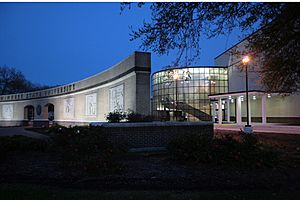
The city has one university and one community college. McNeese State University, on a 121-acre (0.49 km2) campus lined with oak trees in the heart of Lake Charles, is a four-year public university in the University of Louisiana System. Contraband Bayou flows through it. McNeese was founded in 1939 and named after educator John McNeese. It offers over 80 majors, and includes the colleges of Business, Education, Engineering and Engineering Technology, Liberal Arts, Nursing, Science, Honors College, and the Doré School of Graduate Studies. It is accredited by the Commission on Colleges of the Southern Association of Colleges and Schools. Other properties include a 65-acre (260,000 m2) athletic plant and student apartment complex, the Louisiana Environmental Research Center, Burton Coliseum, the 503-acre (2.04 km2) MSU Farm, and nearly 1,600 acres (6.5 km2) of donated farm property used for research, farming, and ranching. Over 8,500 students attend McNeese.
Sowela Technical Community College offers associate degrees, technical diplomas, certificate programs, and general education courses that can transfer to four-year universities. Delta School of Business and Technology specializes in vocational courses.
Primary and secondary schools
Lake Charles's public schools are operated by the Calcasieu Parish Public School System. There are two charter schools and several private schools. The Roman Catholic Diocese of Lake Charles operates and/or is affiliated with private Roman Catholic schools.
Infrastructure
Roads
The city's streets are laid out primarily in a grid pattern. Interstate 10 passes through Lake Charles, connecting the city with Houston to the west and New Orleans to the east. The Calcasieu River Bridge crosses the Calcasieu River and part of lake. Featuring decorative flintlock pistols on the railing, it is 135 feet (41 m) high. About 50,000 vehicles pass over it daily. Despite its age of over 60 years, it is considered safe by the Louisiana DOTD.
Interstate 210 is an interstate highway bypass that loops through the southern portion of the city. The curving Israel LaFleur Bridge goes over the Calcasieu Ship Channel. This bridge has a 96% rating even after withstanding recent hurricanes. The loop has served Lake Charles commuters for 40 years, and carries about 40,000 vehicles per day.
Other major highways include U.S. Highway 90, which runs parallel with Interstate 10, and U.S. Highway 171, which connects the city to the north with Moss Bluff, DeRidder, and Shreveport. Highway 165, which runs northeast to Alexandria terminates at Highway 90 just a few miles east of the city. Louisiana Highway 14 ends at a junction with Highway 90, and runs south then east of the city.
Airports
Lake Charles is served by two airports. Lake Charles Regional Airport, located south of the city, provides commercial airline service to Houston and Dallas. Chennault International Airport, while a fully operational airport, is an industrial and maintenance center. The latter airport, a former Strategic Air Command US Air Force base during the Cold War, is named for Maj. Gen. Claire Chennault, the aviator famous for commanding the Flying Tigers fighter group during World War II.
Seaports
The Port of Lake Charles is the thirteenth-busiest seaport in the United States, the fourth-largest liner service seaport in the U.S. Gulf, and a major West Gulf container load center. The City Docks in Lake Charles are the main hub of shipping activity. The Calcasieu Ship Channel provides direct access to the Gulf of Mexico 34 miles (55 km) downstream. The ship channel, which has a projected depth of 40 feet (12 m) and a bottom width of 400 feet (120 m), intersects the Gulf Intracoastal Waterway just north of Calcasieu Lake.
Public transportation
Lake Charles Transit, the city's bus system, provides five routes throughout the city. It has one Greyhound bus station, and the Amtrak station serves the Sunset Limited train route.
Utilities
Electrical needs are provided by the energy company Entergy. The city provides drinking water and sewage service to residents within city limits. Water is treated at six water treatment facilities in the city.
Healthcare and medicine
Lake Charles is served by two hospitals with multiple locations. Christus St. Patrick Hospital operates the Lake Area Medical Center campus in south Lake Charles, and Lake Charles Memorial Hospital operates a birthing hospital called Lake Charles Memorial Hospital for Women.
Images for kids
See also
 In Spanish: Lake Charles (Luisiana) para niños
In Spanish: Lake Charles (Luisiana) para niños






